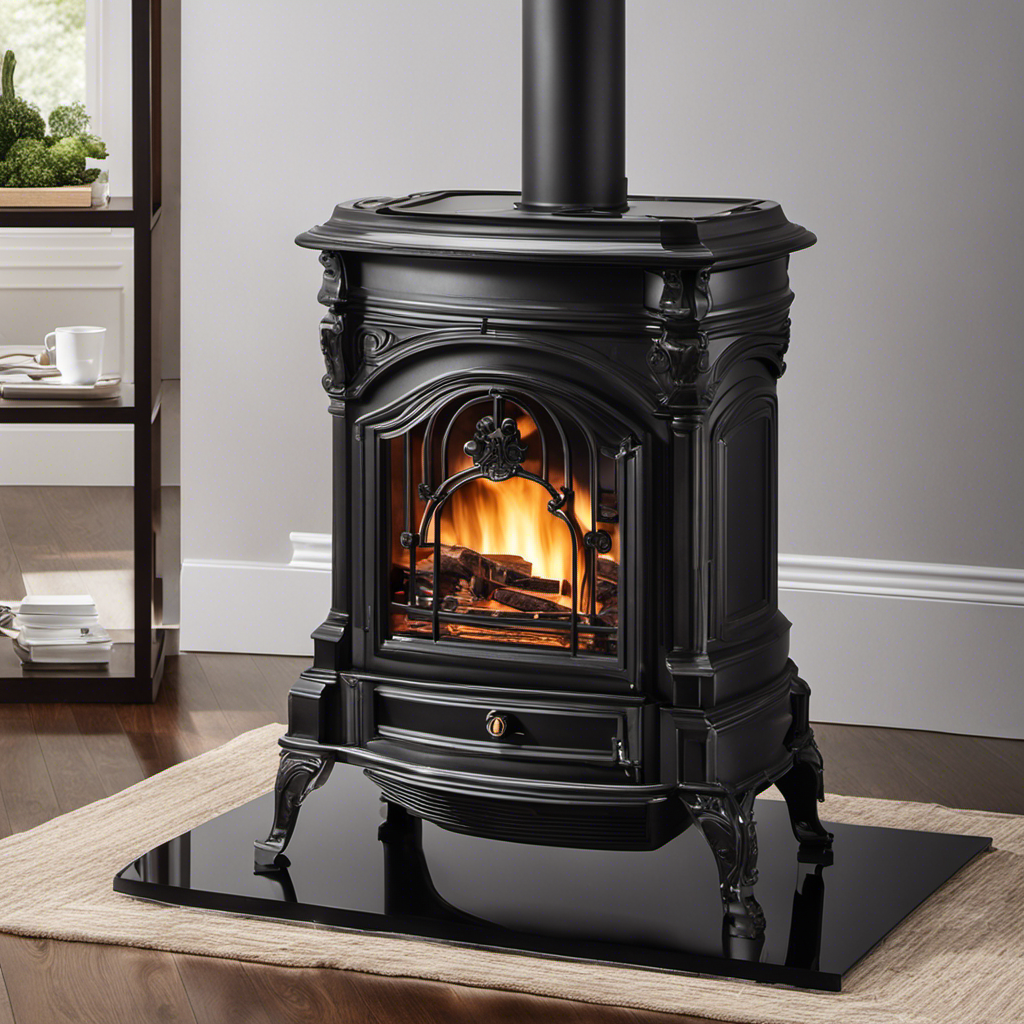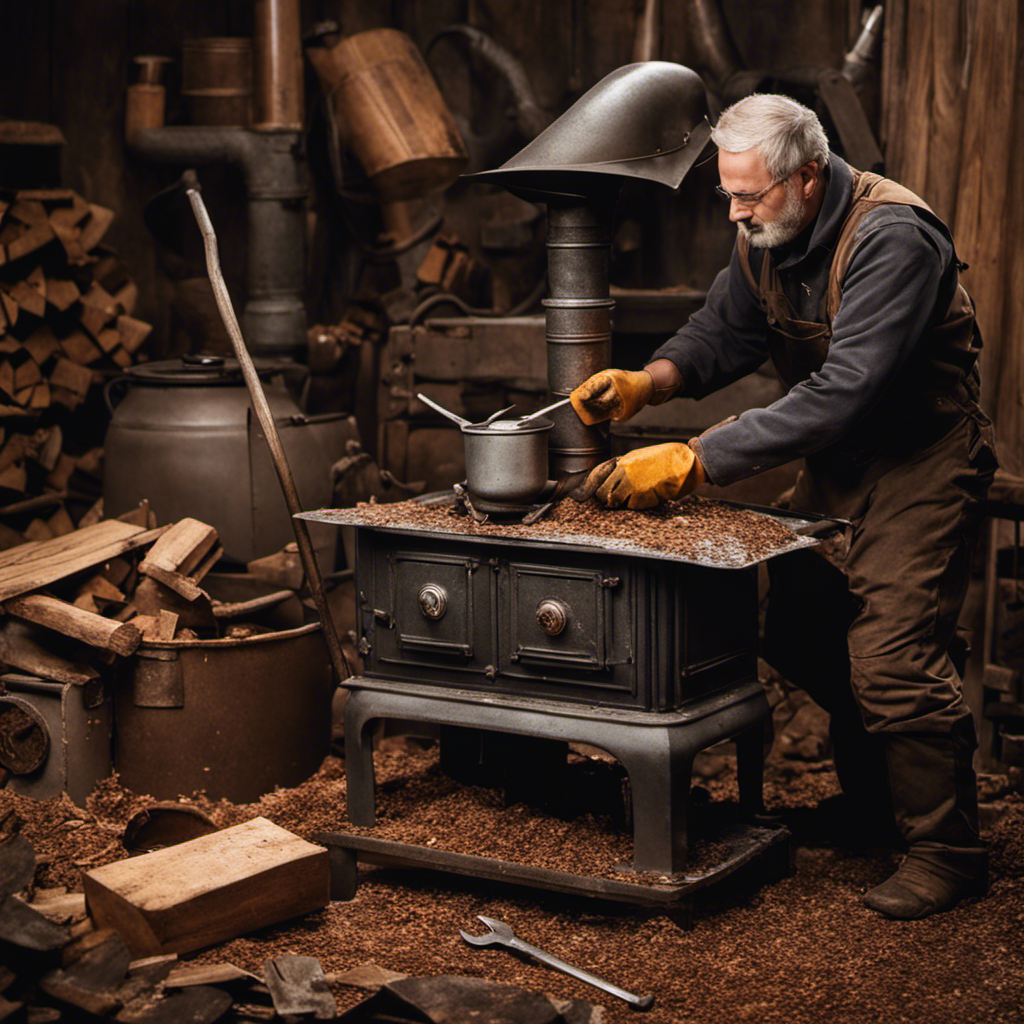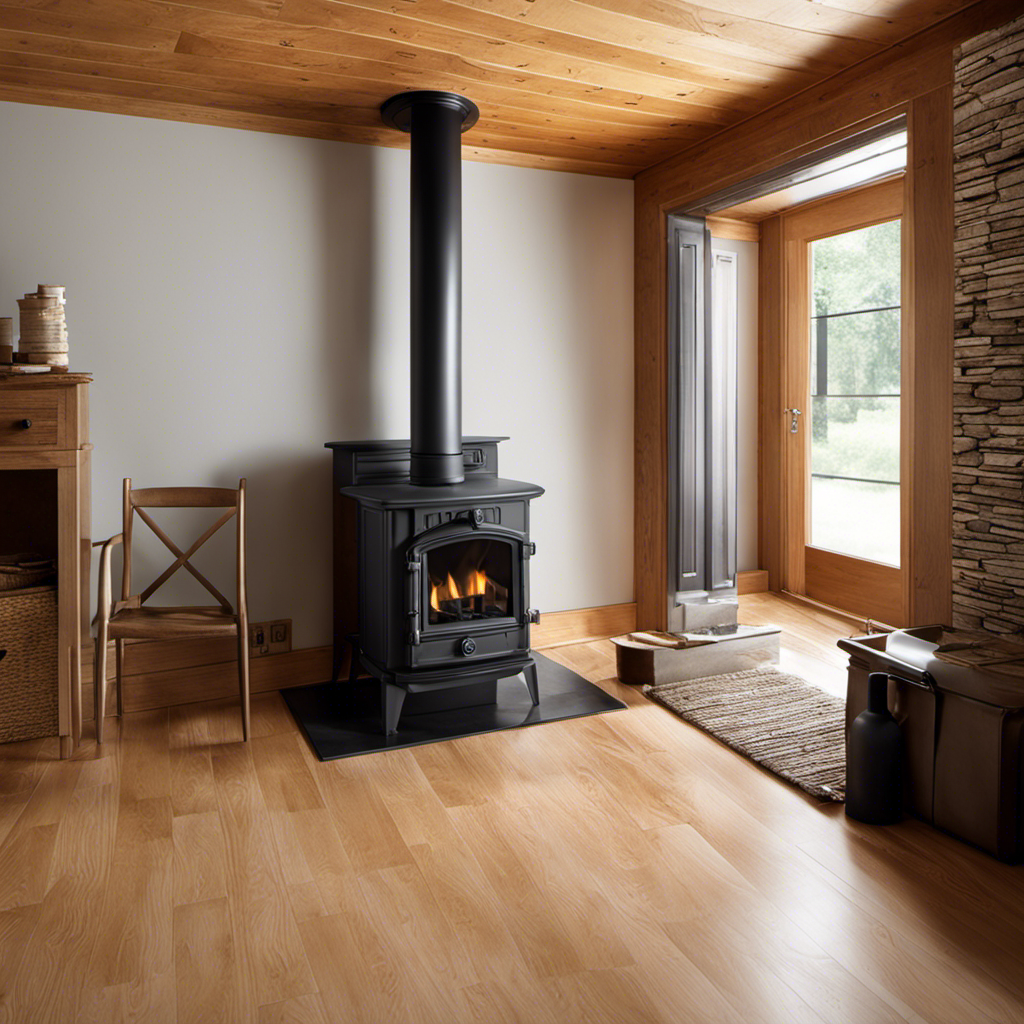Wood Stove
How To Move A Wood Stove By Yourself
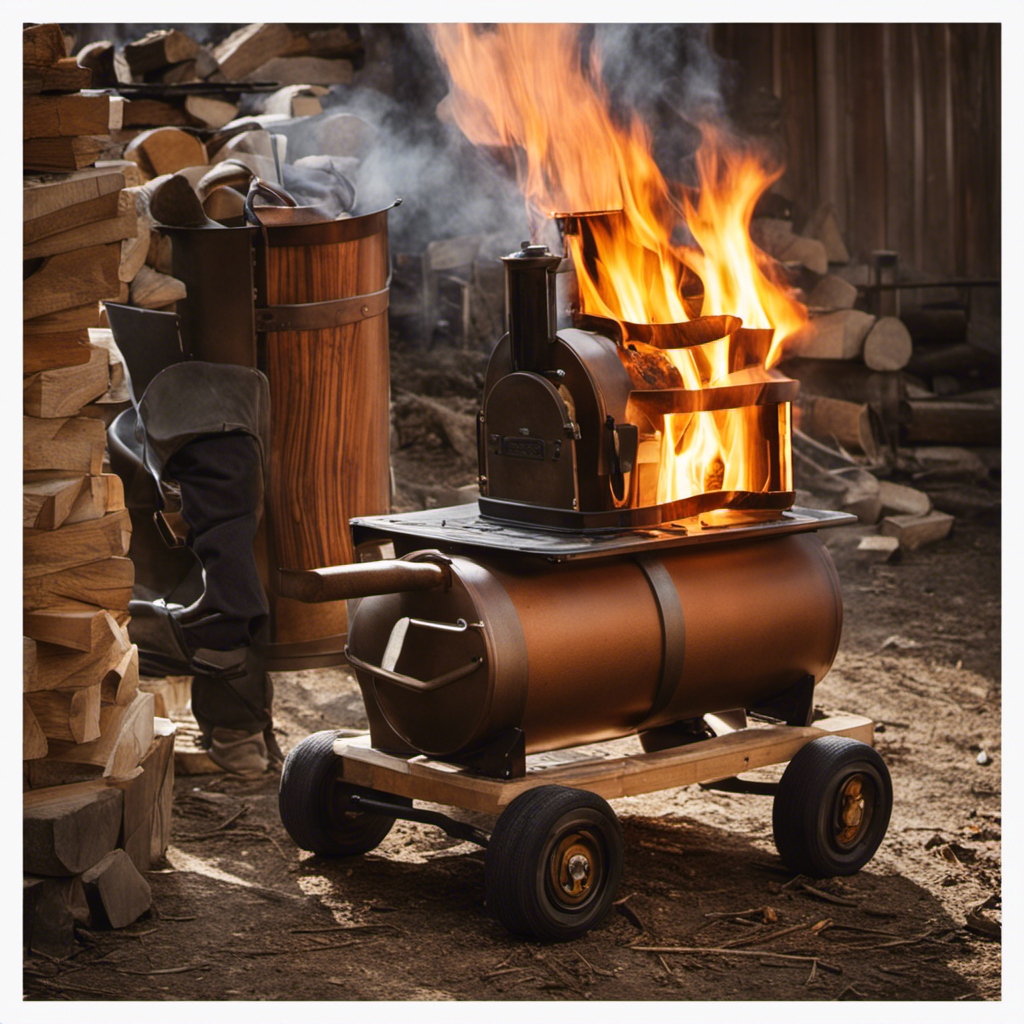
Were you aware that it’s both possible and cost-effective to move a wood stove by yourself?
In this article, I’ll guide you through the process of safely and efficiently moving your wood stove to a new location.
From assessing its weight and size to gathering the necessary tools, disconnecting, transporting, and reinstalling, I’ll provide you with step-by-step instructions to make this task a breeze.
So, let’s get started and learn how to move a wood stove by yourself!
Key Takeaways
- Assess the dimensions, condition, and layout of the wood stove and the space it needs to be moved through
- Gather the necessary tools and equipment for safe and efficient moving, including a dolly, moving straps, screwdriver, adjustable wrench, moving blankets, and furniture sliders
- Disconnect and remove the wood stove using proper lifting techniques, assistance if needed, and protective measures for the flooring
- Securely transport the wood stove by ensuring it is cooled down, disconnecting and packing loose parts separately, and securing it to a dolly or cart with straps or ropes
Assessing the Weight and Size of the Wood Stove
I can feel the weight of the wood stove as I carefully measure its dimensions. Evaluating the condition of the wood stove is crucial before attempting to move it. I inspect it for any loose or damaged parts that could potentially affect the stability during the move.
Once I’m satisfied with its condition, I determine the best approach for moving the wood stove. I consider factors such as the weight, size, and layout of the space it needs to be moved through. This helps me strategize the most efficient way to navigate corners, narrow doorways, or stairs.
Gathering the Necessary Tools and Equipment
To safely relocate the wood stove, I’ll need to gather the necessary tools and equipment. It’s important to choose the right moving technique and protect the floor during the process. Here are the tools and equipment I recommend having on hand:
| Tools | Equipment |
|---|---|
| Dolly | Moving Straps |
| Screwdriver | Moving Blankets |
| Adjustable Wrench | Furniture Sliders |
The dolly will help you transport the wood stove easily and efficiently. Moving straps will provide extra support and stability during the relocation. A screwdriver and adjustable wrench will be essential for disconnecting the stove from any gas or electrical connections. Moving blankets will protect the wood stove from scratches or dents. Lastly, furniture sliders will make it easier to slide the stove across the floor without causing damage. By gathering these tools and equipment, you’ll be well-prepared to safely move your wood stove.
Disconnecting and Safely Removing the Wood Stove
Disconnecting and safely removing the wood stove requires a series of steps.
First, it is important to turn off the gas and electricity connections. To do this, shut off the gas valve and unplug the stove from the electrical outlet.
Next, attention can be turned to the chimney connections. Remove the chimney cap and then disconnect the chimney connections. Protective gloves should be worn, and a wrench should be used to loosen the screws holding the chimney pipes together.
Once the chimney is disconnected, the actual removal of the stove can begin. Carefully lift the stove off the floor, making use of a dolly or furniture sliders to prevent damage to the flooring. To provide additional protection to the flooring, place a thick blanket or cardboard underneath the stove.
It is important to remember that wood stoves can be heavy, so it is crucial to utilize proper lifting techniques and have someone assist you if needed.
Securing and Transporting the Wood Stove to the New Location
Carefully securing the wood stove is essential before transporting it to the new location. To ensure a safe and successful move, there are several steps you need to follow.
Firstly, make sure the stove is completely cooled down before attempting to move it. This will prevent any accidental burns or injuries.
Next, disconnect any pipes or flue connections and securely cap them to prevent any debris from falling out during transit.
It’s also important to remove any loose or detachable parts, such as handles or knobs, and pack them separately to avoid damage.
Once everything is disconnected and removed, use straps or sturdy ropes to secure the stove to a dolly or cart. This will make it easier to maneuver and prevent it from shifting during transport.
Finally, cover the stove with a protective blanket or tarp to prevent any scratches or damage.
Reinstalling and Testing the Wood Stove in Its New Position
I successfully reinstalled the wood stove in its new position and tested it for proper functionality. The process of reconnecting the stove to the chimney and ensuring proper ventilation was crucial in order to safely use the wood stove. Here are the steps I followed:
Reconnecting the stove to the chimney:
- Carefully align the stovepipe with the chimney flue.
- Secure the stovepipe with screws or clamps to prevent any leaks.
Ensuring proper ventilation:
- Clear any debris or obstructions from the chimney and flue.
- Open the damper to allow for proper airflow.
By reconnecting the stove to the chimney, I ensured that the smoke and gases produced by the wood stove would be safely vented outside. Proper ventilation is essential to prevent the buildup of harmful carbon monoxide and maintain efficient combustion.
With these steps completed, I was confident that the wood stove was ready to provide warmth and comfort in its new position.
Frequently Asked Questions
Can I Move a Wood Stove by Myself Without Any Help?
Yes, I can move a wood stove by myself without any help. However, it is important to follow proper moving techniques and take safety precautions to avoid injury or damage to the stove or myself.
How Long Does It Typically Take to Move a Wood Stove?
On average, it takes about 2-3 hours to move a wood stove. Here are some tips and tricks to make the process easier: gather the necessary tools, protect the floor, and enlist the help of a dolly or furniture sliders.
Do I Need Any Special Permits or Licenses to Move a Wood Stove?
Moving a wood stove by myself may require special permits or licenses. It’s important to check local regulations and ensure safety precautions are followed. Failure to comply could result in fines or other consequences.
Can I Use Any Type of Vehicle to Transport a Wood Stove?
I can use various vehicles for transporting a wood stove. The best options include a pickup truck, a trailer, or a moving van. It is important to secure the stove properly and ensure it is not damaged during transportation.
What Should I Do if I Encounter Any Obstacles or Difficulties During the Wood Stove Moving Process?
If I encounter any obstacles or difficulties during the wood stove moving process, I would take a moment to assess the situation, come up with a plan to overcome them, and ask for help if needed.
Conclusion
In conclusion, moving a wood stove by yourself requires careful planning and the right tools. Assessing the weight and size of the stove is crucial to ensure a safe and successful move.
Gathering the necessary equipment, disconnecting the stove properly, and securing it during transportation are all important steps.
Finally, reinstalling and testing the stove in its new location will ensure that it functions properly. Remember, ‘measure twice, cut once’ to avoid any mishaps during the process.
Growing up surrounded by the vast beauty of nature, Sierra was always drawn to the call of the wild. While others sought the comfort of the familiar, she ventured out, embracing the unpredictable and finding stories in the heartbeat of nature.
At the epicenter of every remarkable venture lies a dynamic team—a fusion of diverse talents, visions, and passions. The essence of Best Small Wood Stoves is crafted and refined by such a trio: Sierra, Logan, and Terra. Their collective expertise has transformed the platform into a leading authority on small wood stoves, radiating warmth and knowledge in equal measure.
Wood Stove
What Happens When Aluminum Is Put A Wood Stove
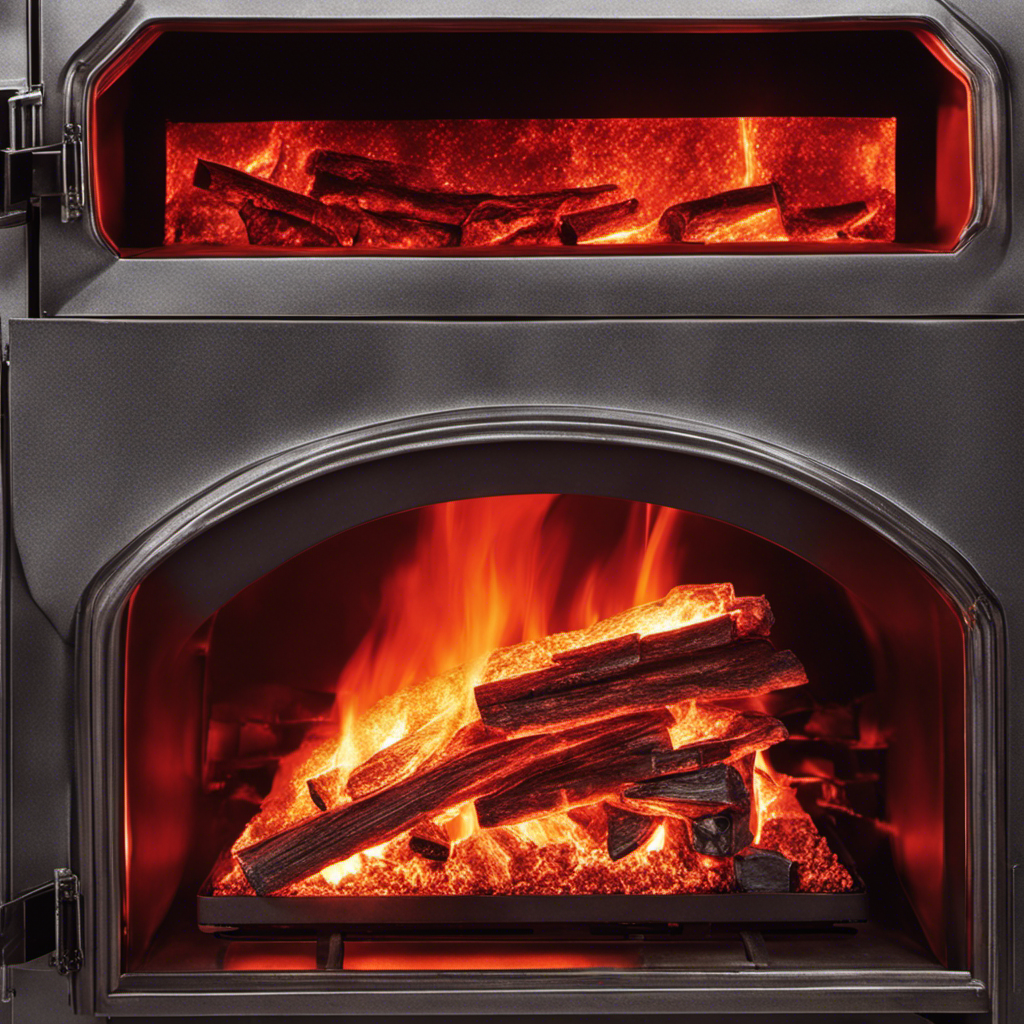
When I throw a thin aluminum strip into the powerful flames of my wood-burning stove, a captivating chemical reaction takes place right before my eyes. In this article, I will explore the scientific principles that can help us understand this mesmerizing phenomenon.
By exploring the thermal properties of aluminum, the combustion and oxidation processes, and the impact on the stove’s efficiency, we can uncover the intricate mechanisms at play.
However, we must also consider safety precautions when experimenting with this fiery interaction.
Let’s delve into the captivating world of aluminum and wood stove combustion.
Key Takeaways
- Aluminum undergoes oxidation when exposed to oxygen in the air, and the intense heat in a wood stove accelerates this process.
- The chemical reaction between aluminum and oxygen produces aluminum oxide, and the high temperature in the wood stove provides the energy for the reaction.
- Aluminum has high thermal conductivity and is commonly used in industries like automotive, aerospace, and electronics for efficient heat transfer.
- Using aluminum foil in a wood stove reflects heat back into the firebox, improves combustion, reduces energy consumption, helps distribute heat evenly, and can lower fuel consumption.
The Science Behind the Reaction
I can explain the science behind the reaction between aluminum and a wood stove.
When aluminum is put in a wood stove, a chemical reaction occurs due to the intense heat. Aluminum is a highly reactive metal, and when it comes into contact with oxygen in the air, it undergoes oxidation. The heat from the wood stove accelerates this process, causing the aluminum to react even more rapidly.
This chemical reaction produces aluminum oxide, which is a compound of aluminum and oxygen. The heat transfer in this reaction is significant, as the high temperature of the wood stove provides the energy needed for the reaction to take place.
Overall, the combination of the chemical reaction and heat transfer results in the aluminum undergoing a transformation in the wood stove.
Thermal Properties of Aluminum
Although aluminum is a metal, it has impressive thermal conductivity properties that make it an excellent choice for various heat transfer applications. The conductivity of aluminum is one of the highest among all metals, allowing it to efficiently transfer heat from one area to another. This is due to its crystal structure, which allows for the easy movement of heat-carrying electrons. Additionally, aluminum has a relatively low melting point of 660 degrees Celsius, making it suitable for applications where high temperatures are involved.
The high thermal conductivity of aluminum makes it particularly useful in industries such as automotive, aerospace, and electronics, where efficient heat transfer is crucial for optimal performance. In heat exchangers, for example, aluminum is commonly used as it can quickly absorb and distribute heat, ensuring efficient cooling. Similarly, in electronic devices, aluminum is often used as a heat sink material to dissipate excess heat generated by components.
Combustion and Oxidation Processes
The combustion of wood in a stove releases heat and carbon dioxide as byproducts. This process is driven by chemical reactions between the wood and oxygen in the air.
The heat generated during combustion is transferred to the surrounding environment through conduction, convection, and radiation. Chemical reactions occur when the wood is exposed to high temperatures, causing it to decompose into various volatile gases, such as methane, carbon monoxide, and hydrogen. These gases then react with oxygen to produce carbon dioxide and water vapor.
The heat transfer in a wood stove is primarily through convection, where hot gases rise and escape through the chimney, while cooler air is drawn in to replace it. This continuous cycle ensures efficient heat transfer and a steady supply of oxygen for the combustion process.
Impact on the Wood Stove’s Efficiency
Using aluminum foil in a wood stove can improve its efficiency, as it reflects heat back into the firebox. This simple technique can have a significant impact on heat distribution and energy consumption. Here are five reasons why using aluminum foil in a wood stove is beneficial:
-
Increased Heat Reflection: The shiny surface of aluminum foil reflects heat back into the firebox, preventing it from escaping through the stove walls.
-
Improved Combustion: By reflecting heat, aluminum foil ensures that the fire burns at a higher temperature, leading to more efficient combustion and reduced energy consumption.
-
Enhanced Heat Distribution: Aluminum foil helps distribute heat more evenly throughout the stove, preventing hot spots and ensuring a consistent temperature.
-
Reduced Heat Loss: With heat reflecting back into the firebox, less heat is lost through the stove walls, resulting in improved overall efficiency.
-
Lower Fuel Consumption: By maximizing heat retention and distribution, the use of aluminum foil in a wood stove can help reduce fuel consumption, saving both money and resources.
Safety Considerations and Precautions
I take adequate safety precautions and carefully follow guidelines to ensure my well-being when using aluminum foil in my wood stove. Ventilation requirements are crucial when using aluminum foil as it can release toxic fumes if heated to high temperatures without proper airflow. It’s essential to ensure that the wood stove is properly vented to prevent the accumulation of harmful gases.
Additionally, handling and disposal of aluminum residue should be done with caution. Aluminum foil remnants should be cool before handling to avoid burns. Proper disposal methods should be followed, such as recycling the foil or disposing of it in designated waste bins.
Frequently Asked Questions
How Long Does It Take for Aluminum to Completely Burn in a Wood Stove?
The burn time for aluminum in a wood stove depends on various factors such as temperature and airflow. It can take anywhere from a few minutes to several hours for aluminum to completely burn. However, this process can release harmful emissions and negatively impact air quality.
Will Putting Aluminum in a Wood Stove Release Any Harmful Gases?
When aluminum is burned in a wood stove, it can release toxic fumes. The environmental impacts of this process include the emission of harmful gases and the potential for air pollution.
Can the Combustion of Aluminum in a Wood Stove Damage the Stove’s Interior?
The combustion of aluminum in a wood stove can potentially damage the stove’s interior and affect its performance. This is because the high heat generated during the combustion process can cause the aluminum to melt or warp, posing a fire hazard.
Is It Possible to Recycle the Aluminum Ash Left Behind After Burning It in a Wood Stove?
Recycling aluminum ash is possible, but the environmental impact of aluminum combustion must be considered. As an active participant in the process, I can tell you that proper recycling methods should be followed to reduce waste and promote sustainability.
What Are the Potential Risks of Using Aluminum in a Wood Stove, Both to the Stove Itself and to the Surrounding Environment?
Potential health hazards and environmental impact should be considered when using aluminum in a wood stove. The stove’s integrity may be compromised, leading to safety issues, and aluminum ash can release harmful toxins into the air, soil, and water.
Conclusion
In conclusion, when aluminum is put in a wood stove, it undergoes a combustion and oxidation process due to the high temperature. This reaction releases heat and produces aluminum oxide, which can impact the efficiency of the wood stove.
It’s important to consider safety precautions when introducing aluminum into a wood stove. Interestingly, the combustion of aluminum releases approximately 31,000 BTUs per pound, providing a visual representation of its potential energy output.
Wood Stove
What Is The Twistable Knob On A Wood Stove For

If you are the owner of a wood stove, have you ever questioned the function of the twistable knob?
Well, prepare to have your curiosity stoked. The twistable knob on a wood stove is like the conductor of an orchestra, controlling the airflow and ultimately the temperature inside your stove.
It’s a crucial instrument for achieving optimal heating efficiency. In this article, I will guide you through the purpose, function, and troubleshooting of this mysterious knob, ensuring you can make the most of your wood stove experience.
Key Takeaways
- The twistable knob on a wood stove controls airflow and heat output by adjusting the amount of oxygen entering the combustion chamber.
- It is connected to a damper that regulates air intake, opening the damper increases airflow and fire intensity, while closing it reduces airflow and fire intensity.
- Turning the twistable knob counterclockwise increases the temperature, while turning it clockwise decreases the temperature.
- Regular maintenance, including cleaning and lubrication, is necessary for proper functionality and optimizing the stove’s performance.
Understanding the Purpose of the Twistable Knob
I’m still not sure about the purpose of the twistable knob on a wood stove, but understanding its function seems crucial.
The twistable knob on a wood stove serves a vital role in controlling the airflow and heat output of the stove. It’s usually located on the front or side of the stove and can be easily adjusted to regulate the amount of oxygen that enters the combustion chamber. By turning the knob, you can increase or decrease the intensity of the fire, thus controlling the temperature inside the stove.
This feature is particularly useful for achieving optimal efficiency and preventing overheating. Different types of wood stove twistable knobs may include air intake knobs, damper knobs, and secondary air control knobs, each with their specific functions.
Proper maintenance and cleaning of wood stoves, including regular inspection and lubrication of the twistable knob, are essential to ensure its smooth operation and longevity.
How the Twistable Knob Controls Airflow
The twistable knob on a wood stove controls the airflow, allowing me to adjust the intensity of the fire. Understanding the mechanics of this twistable knob is essential to effectively control the combustion process in a wood stove.
The knob is connected to a damper, which regulates the amount of air that enters the stove. By twisting the knob, I can open or close the damper, thereby controlling the amount of oxygen that reaches the fire. Increasing the airflow by opening the damper will result in a more intense fire, while reducing the airflow by closing the damper will decrease the intensity.
This adjustment is crucial as it directly affects the combustion process. By managing the airflow, I can ensure efficient and clean burning, optimizing the stove’s performance.
Adjusting the Twistable Knob for Temperature Control
I can adjust the twistable knob by turning it counterclockwise to increase the temperature, or by turning it clockwise to decrease the temperature. The twistable knob is a crucial component of a wood stove as it allows me to control the amount of air reaching the fire, thus regulating the temperature. To ensure proper functionality and longevity of the twistable knob, regular maintenance is necessary. This includes checking for any debris or obstructions that may hinder its movement and cleaning it with a soft cloth. It’s also important to be aware of the different types of twistable knobs available. Some may have a simple design with arrows indicating the direction for temperature adjustment, while others may have numerical values for precise temperature control. Understanding the specific type of twistable knob on my wood stove will help me effectively adjust the temperature and maintain optimal performance.
| Types of Twistable Knobs |
|---|
| Simple Design |
| Numerical Adjustment |
| Color-Coded |
| Digital Display |
| Multi-Function |
The Importance of Properly Using the Twistable Knob
To effectively control the temperature of the wood stove, it’s crucial to properly turn and adjust the twistable knob.
The twistable knob on a wood stove is designed to regulate the airflow and therefore the heat output of the stove. It’s important to understand the mechanics of the knob and how it affects the stove’s performance.
Proper maintenance of the twistable knob is essential to ensure its smooth operation and prevent any malfunctions. Regular cleaning and lubrication are recommended to keep it functioning optimally.
Safety precautions must also be taken when handling the twistable knob. Always make sure to turn off the stove before adjusting the knob to avoid any accidents or burns.
Additionally, it’s important to be aware of the temperature range indicated on the knob and not exceed the recommended limits to prevent overheating or damage to the stove.
Troubleshooting Common Issues With the Twistable Knob
I’ve encountered several common issues with the twistable knob, such as it getting stuck or not turning smoothly. When faced with these problems, it’s essential to utilize troubleshooting techniques to address the issue effectively.
One common cause of a stuck twistable knob is the accumulation of debris or ash around the knob’s base. To resolve this, I recommend performing regular maintenance by cleaning the area around the knob using a soft brush or cloth.
Additionally, lubricating the knob’s mechanism with a high-quality graphite lubricant can improve its smooth operation. If the knob still refuses to turn smoothly, there might be a problem with the internal mechanism. In such cases, it’s advisable to seek professional assistance to avoid further damage.
Frequently Asked Questions
How Often Should I Adjust the Twistable Knob on My Wood Stove?
I adjust the twistable knob on my wood stove periodically to optimize heating efficiency. Cleaning the knob regularly ensures it functions properly. The twistable knob controls the airflow, allowing me to regulate the heat output of the stove.
Can I Use the Twistable Knob to Control the Intensity of the Fire?
Yes, the twistable knob on a wood stove can be used to control the intensity of the fire. By adjusting the knob, you can increase or decrease the amount of airflow to regulate the heat output.
What Happens if I Accidentally Break the Twistable Knob?
If the twistable knob on a wood stove is accidentally broken, it can be replaced. However, it is important to troubleshoot common issues with the knob first, such as checking for any debris or obstructions.
Is It Necessary to Have the Twistable Knob on a Wood Stove?
I wouldn’t dream of having a wood stove without the twistable knob. It’s absolutely necessary for controlling the airflow and regulating the temperature. Let me explain how this genius invention works.
Can the Twistable Knob Be Used to Control the Amount of Smoke Emitted From the Wood Stove?
Yes, the twistable knob on a wood stove can be used to control the amount of smoke emitted. By adjusting the knob, you can regulate the fire intensity, which directly affects the smoke production.
Does the Twistable Knob on a Wood Stove Affect the Amount of Ash Produced?
The twistable knob on a wood stove can indeed influence the amount of ash produced. By adjusting the knob, users can regulate the airflow and control the combustion process. Proper adjustment helps optimize burning efficiency and minimize excessive ash buildup in wood stoves, ensuring cleaner and more efficient heating.
Is a Catalytic or Non-Catalytic Wood Stove Better for Controlling Heat Output?
When it comes to controlling heat output, the choice between catalytic and non-catalytic wood stoves is a key factor. Catalytic vs non-catalytic wood stoves differ in their combustion process. Catalytic stoves use a catalyst to burn off smoke at lower temperatures, providing efficient and consistent heat. Non-catalytic stoves, on the other hand, provide a quicker and easier start-up but may have less precise heat control. Ultimately, the decision between the two depends on personal preferences and specific heating needs.
Conclusion
In conclusion, the twistable knob on a wood stove plays a crucial role in controlling the airflow and temperature within the stove. It acts as a metaphorical compass, guiding the user towards achieving the desired warmth and efficiency.
Just like a captain navigating through rough seas, understanding how to properly adjust and utilize the twistable knob is essential for a smooth and enjoyable wood stove experience.
So, remember to pay attention to this small but powerful tool to make the most out of your wood stove.
Growing up surrounded by the vast beauty of nature, Sierra was always drawn to the call of the wild. While others sought the comfort of the familiar, she ventured out, embracing the unpredictable and finding stories in the heartbeat of nature.
At the epicenter of every remarkable venture lies a dynamic team—a fusion of diverse talents, visions, and passions. The essence of Best Small Wood Stoves is crafted and refined by such a trio: Sierra, Logan, and Terra. Their collective expertise has transformed the platform into a leading authority on small wood stoves, radiating warmth and knowledge in equal measure.
Wood Stove
How To Remove Hearthstone Tribute Wood Stove Secondary Air Manifold
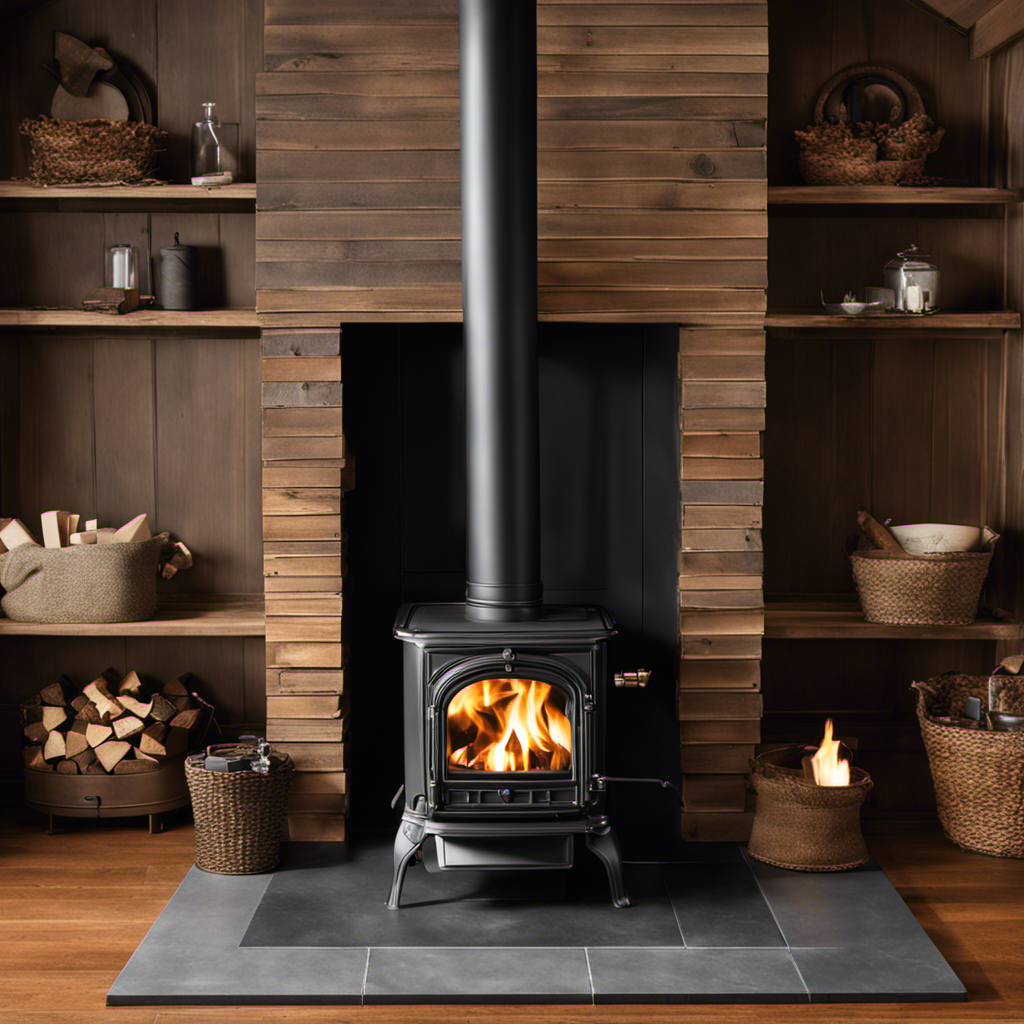
I’ve always enjoyed basking in the warm glow of my Hearthstone Tribute wood stove.
But recently, I noticed a decrease in its efficiency.
After some investigation, I discovered that the secondary air manifold might be clogged.
In this article, I’ll guide you through the process of removing the manifold, cleaning it, and inspecting for any issues.
By the end, your wood stove will be back to its optimal performance, keeping you cozy all winter long.
Key Takeaways
- Prepare the stove by cleaning it thoroughly and disconnecting power sources
- Use penetrating oil to loosen stuck or corroded bolts before removing the secondary air manifold
- Regularly clean and inspect the manifold for debris, soot buildup, cracks, and leaks
- When reinstalling the manifold, ensure the mating surfaces are clean, use a new gasket, and tighten the bolts evenly for a tight seal
Checking the Tools and Materials Needed
I need to make sure I’ve all the tools and materials required before starting the project. Safety precautions are essential when working with any heating appliance, so I’ll need safety goggles, gloves, and a dust mask to protect myself from any potential hazards.
Troubleshooting common issues may also require additional tools such as a flashlight, a screwdriver set, and pliers. It’s crucial to have these tools readily available to address any unexpected problems that may arise during the removal process.
Additionally, I’ll need to gather the necessary materials, including a new secondary air manifold, high-temperature silicone sealant, and a wire brush for cleaning.
Preparing the Stove for Manifold Removal
Before starting the removal process, it’s important to carefully clean the stove and disconnect the necessary components. This will ensure a smooth and efficient removal of the Hearthstone Tribute Wood Stove Secondary Air Manifold.
Here are a few key steps to follow when preparing the stove for removal:
-
Clean the stove thoroughly, removing any ash or debris that may have accumulated. This will prevent any dirt from entering the components during removal.
-
Disconnect the stove from any power sources and shut off the gas supply if applicable. Safety should always be the top priority when working with any appliance.
-
Troubleshoot common issues that may arise during removal, such as stuck or corroded bolts. Using penetrating oil and carefully applying pressure can help loosen stubborn parts.
Removing the Secondary Air Manifold
To successfully remove the secondary air manifold, carefully unscrew the bolts from the stove and gently slide it out from underneath the stove’s top plate.
The Hearthstone Tribute Wood Stove is a reliable and efficient heating source, but like any appliance, it may encounter common issues over time. Troubleshooting these issues is essential to ensure proper functioning.
Some common problems with the wood stove’s secondary air manifold include clogging and restricted airflow. Regular maintenance is key to maintaining the efficiency of the secondary air manifold.
It’s recommended to clean the manifold regularly by removing any buildup or debris. Additionally, checking for any leaks or cracks in the manifold and replacing damaged parts will help optimize its performance.
Cleaning and Inspecting the Manifold
The best way to ensure proper functioning of the secondary air manifold is to regularly clean and inspect it for any clogging or damage. The manifold plays a crucial role in the efficient operation of the wood stove, so it’s important to keep it in good condition.
Here are some key points to consider when inspecting the manifold:
-
Look for any signs of clogging, such as debris or soot buildup. A clogged manifold can restrict airflow and hinder the stove’s performance.
-
Check for any damage, such as cracks or leaks. These can lead to air leakage and affect the stove’s ability to generate heat.
-
Troubleshoot common issues, such as a misaligned or loose manifold. These problems can be easily fixed by adjusting or tightening the manifold.
Reinstalling the Secondary Air Manifold
After inspecting the secondary air manifold, I’ll reinstall it using a gasket and then secure it with bolts. When reinstalling the secondary air manifold, it’s important to ensure a proper seal to prevent any air leaks.
Start by cleaning the mating surfaces of the manifold and the stove body to remove any debris or old gasket material. Then, place a new gasket onto the manifold and align it with the bolt holes on the stove body. Carefully lower the manifold into position, making sure the gasket remains in place.
Once aligned, secure the manifold with the bolts, tightening them evenly to ensure a tight seal. Finally, check for any signs of air leaks and troubleshoot common issues such as loose bolts or a damaged gasket.
Frequently Asked Questions
How Long Does It Typically Take to Remove the Secondary Air Manifold From a Hearthstone Tribute Wood Stove?
Typically, it takes me about 15 minutes to remove the secondary air manifold from my Hearthstone Tribute wood stove. It’s a simple process that involves a few screws and careful maneuvering.
Can the Secondary Air Manifold Be Cleaned Without Removing It From the Stove?
Yes, the secondary air manifold can be cleaned without removing it from the stove. Regular maintenance and cleaning techniques for other parts of the wood stove are essential for optimal stove performance.
Is It Necessary to Inspect the Manifold for Any Specific Issues During the Cleaning Process?
Inspecting the manifold for specific issues during the cleaning process is necessary. Regularly inspecting the manifold is important to ensure its proper functioning and to identify any potential problems that may arise.
Are There Any Recommended Cleaning Agents or Solutions That Should Be Used When Cleaning the Secondary Air Manifold?
When cleaning the secondary air manifold of a Hearthstone Tribute Wood Stove, it is important to use recommended cleaning agents and follow the best cleaning techniques. This ensures a thorough and effective cleaning process.
Are There Any Common Mistakes to Avoid When Reinstalling the Secondary Air Manifold?
When reinstalling the secondary air manifold, it’s important to avoid common mistakes. One tip is to ensure a secure fit by tightening the screws evenly. Another is to double-check all connections for any leaks or gaps.
What is the Best Method to Remove Gunk from Wood Stove Windows?
When it comes to removing gunk from wood stove windows, there are several effective methods. One of the best approaches is to use a combination of vinegar and water. Simply mix equal parts of vinegar and water, apply the solution to the gunk, and let it sit for a few minutes. Then, scrub the residue off with a soft cloth or sponge. This method is not only affordable but also environmentally friendly.
Conclusion
After carefully removing and cleaning the secondary air manifold from your Hearthstone Tribute wood stove, you can reinstall it to ensure optimal performance.
Just like a conductor guiding an orchestra, the manifold plays a crucial role in directing the flow of air and fuel, enhancing the stove’s efficiency and heat output.
By maintaining and inspecting this component regularly, you can ensure that your wood stove continues to provide warmth and comfort for years to come.
Logan’s affair with adventure began in childhood. He hailed from a small town where vast forests bordered one side and endless shores stretched on the other. His days were spent exploring uncharted woods, climbing tall trees, or listening to the tales of old sailors. This early immersion in a world brimming with stories and mysteries became the foundation of his passion for writing.
-

 Wood Stove3 months ago
Wood Stove3 months agoHow To Build A Thermoelectric Generator For A Wood Stove
-
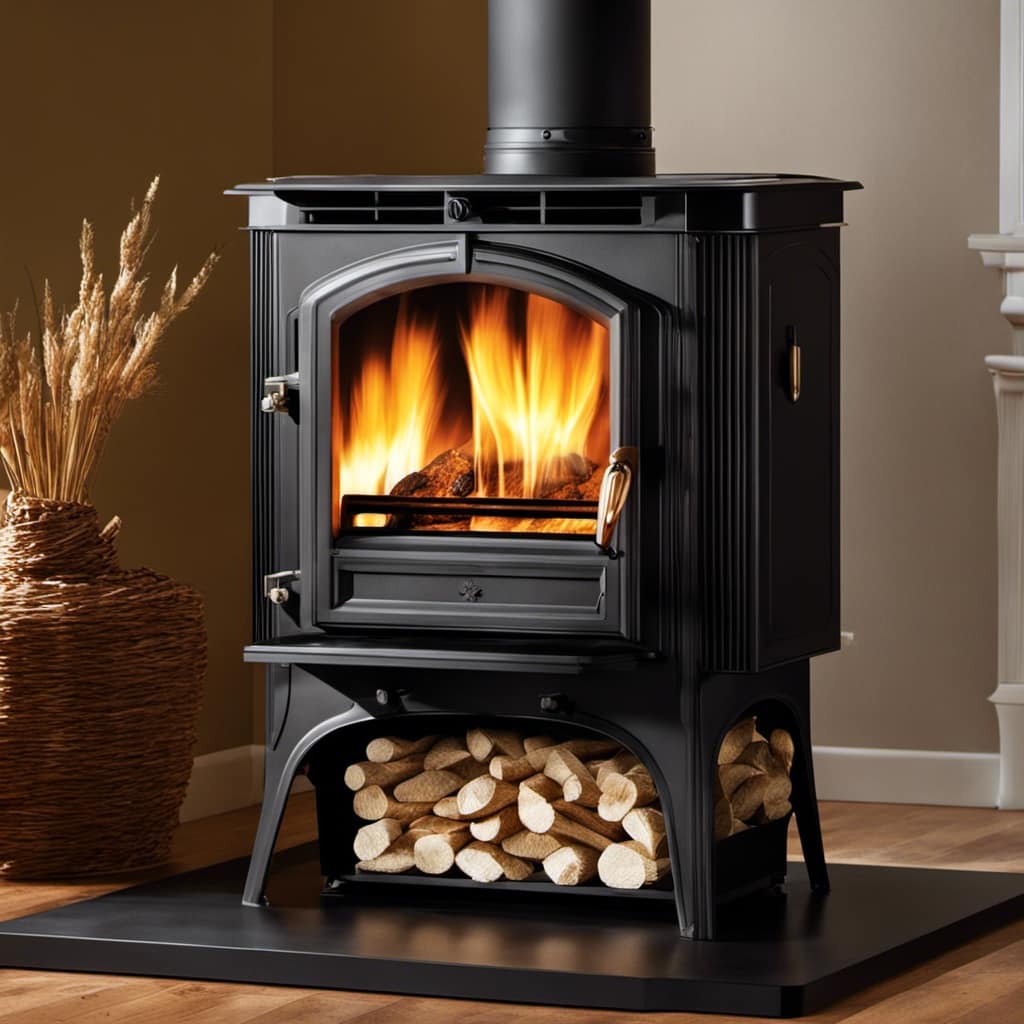
 Wood Stove4 months ago
Wood Stove4 months agoHow To Use Damper And Draft On Wood Stove
-

 Wood Stove4 months ago
Wood Stove4 months agoWhen To Open And Close Damper On Wood Stove
-

 Wood Stove3 months ago
Wood Stove3 months agoHow Far Does Wood Stove Have To Be From Wall
-

 Wood Stove3 months ago
Wood Stove3 months agoHow Does A Circulator Wood Stove Work
-
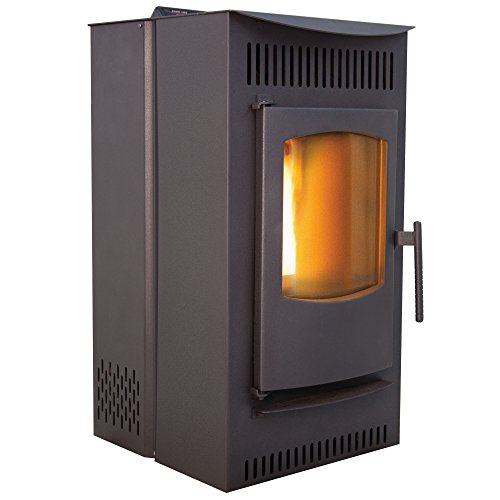
 Pellet Stoves3 months ago
Pellet Stoves3 months agoWhy Is My Wood Pellet Stove Putting so Much Soot
-
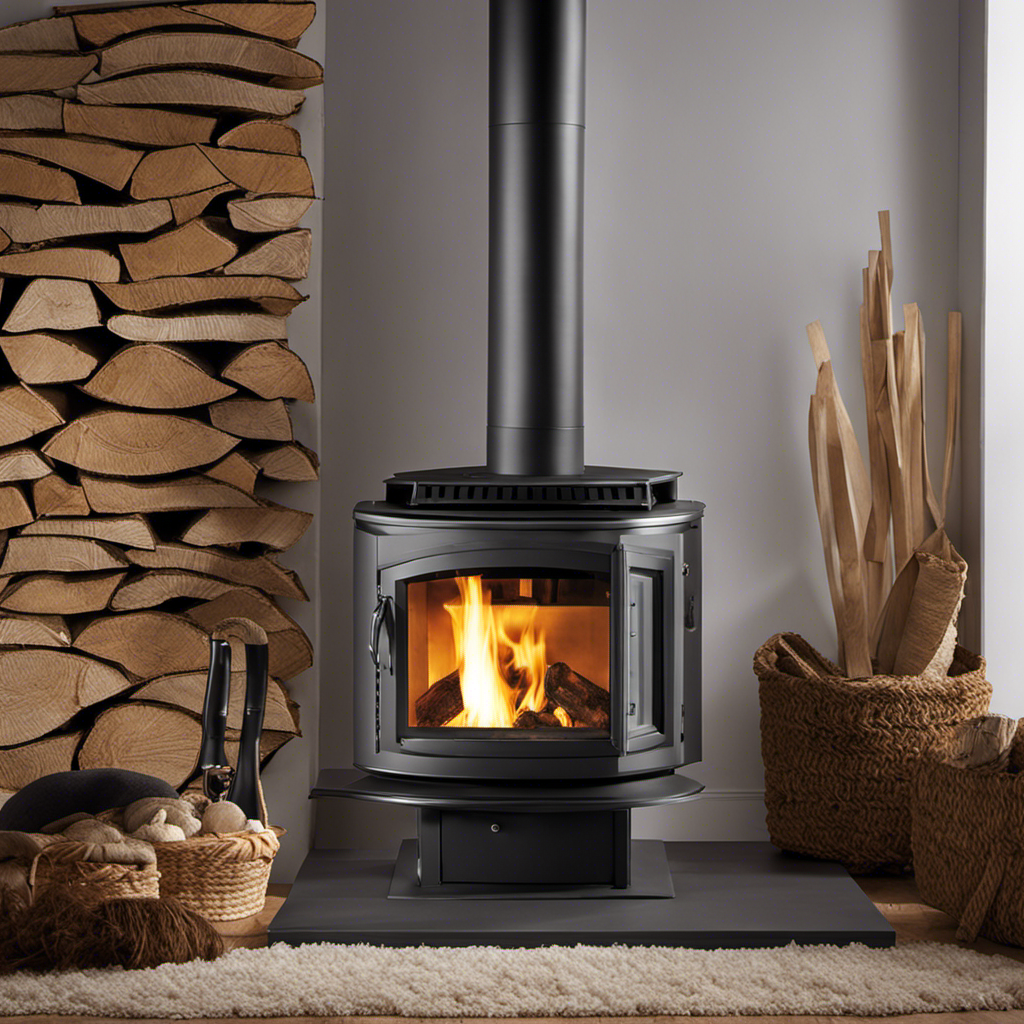
 Wood Stove4 months ago
Wood Stove4 months agoWhat Can I Use As Insulation On Wood Stove Pipes
-
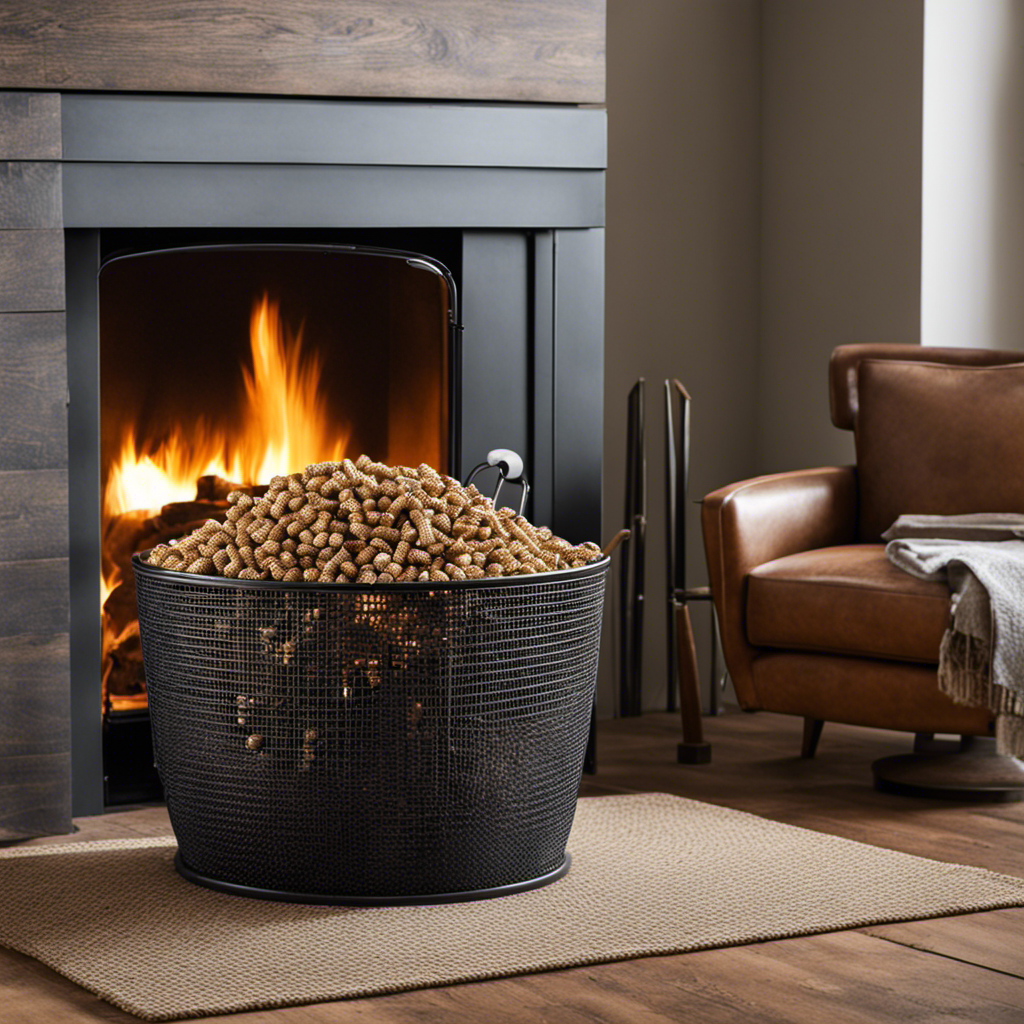
 Pellet Stoves3 months ago
Pellet Stoves3 months agoHow to Make a Pellet Basket for Wood Burning Stoves










